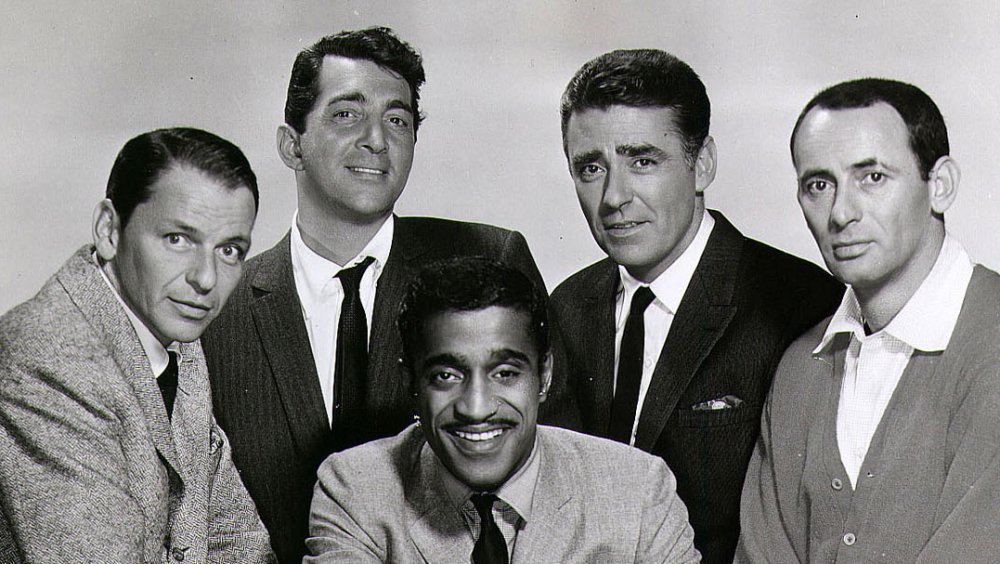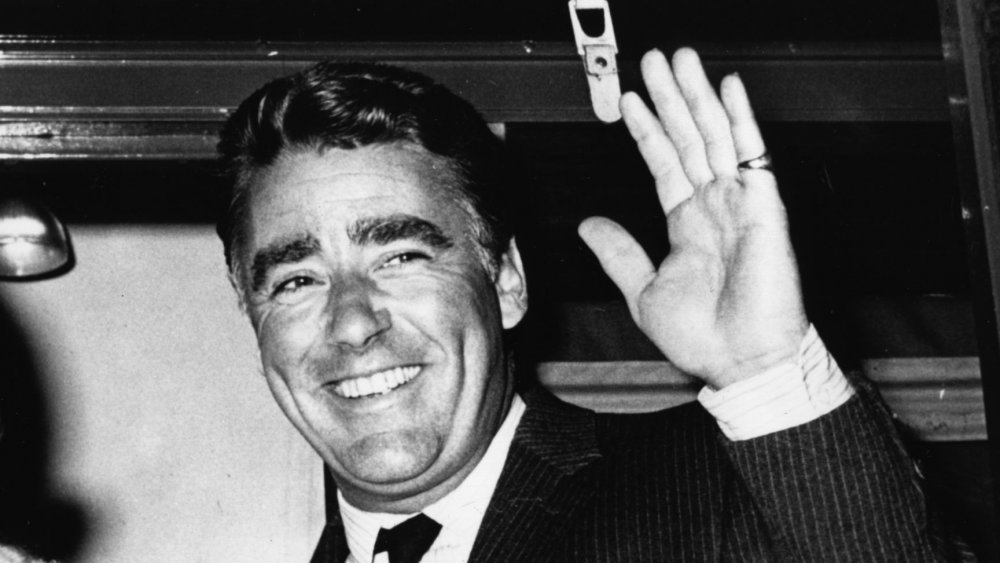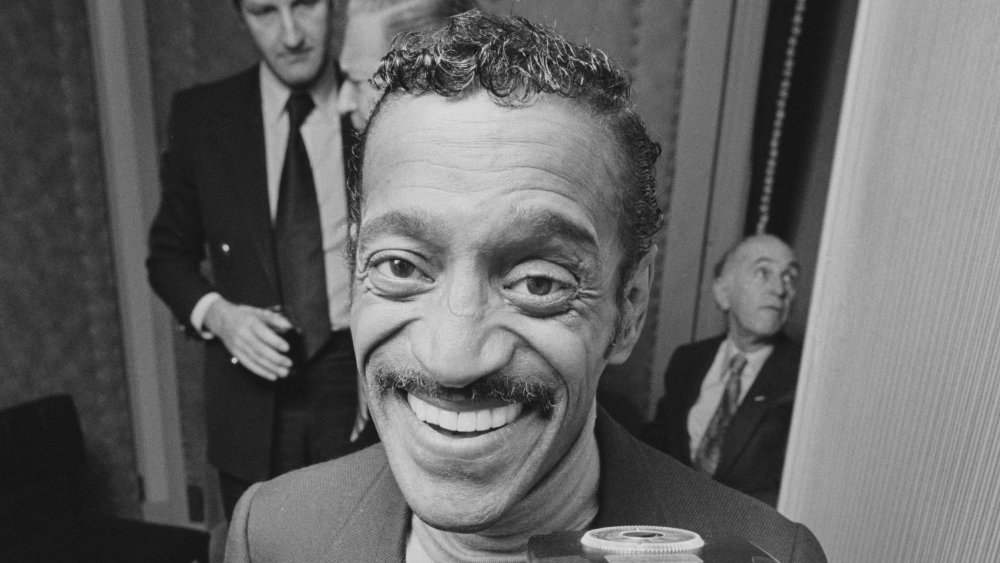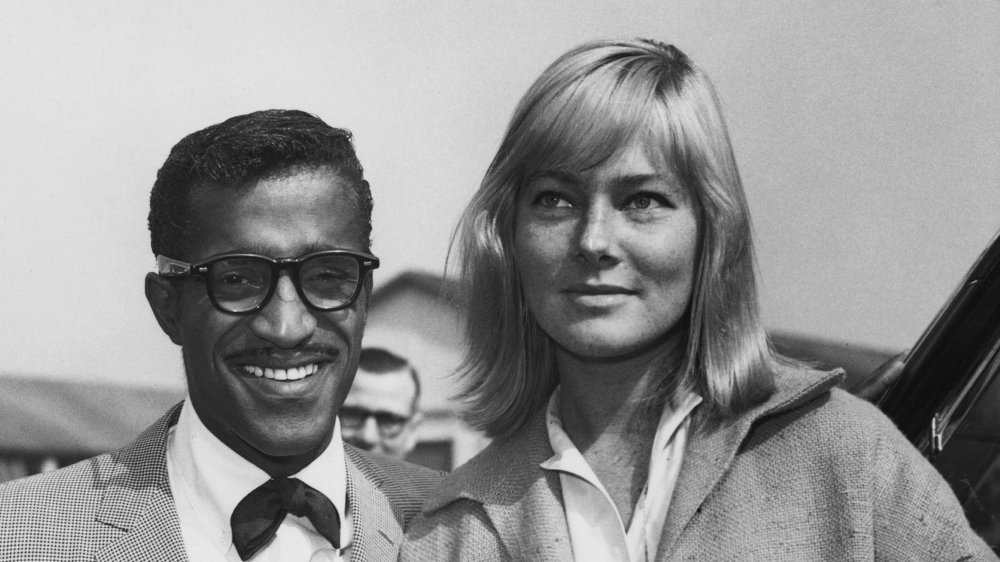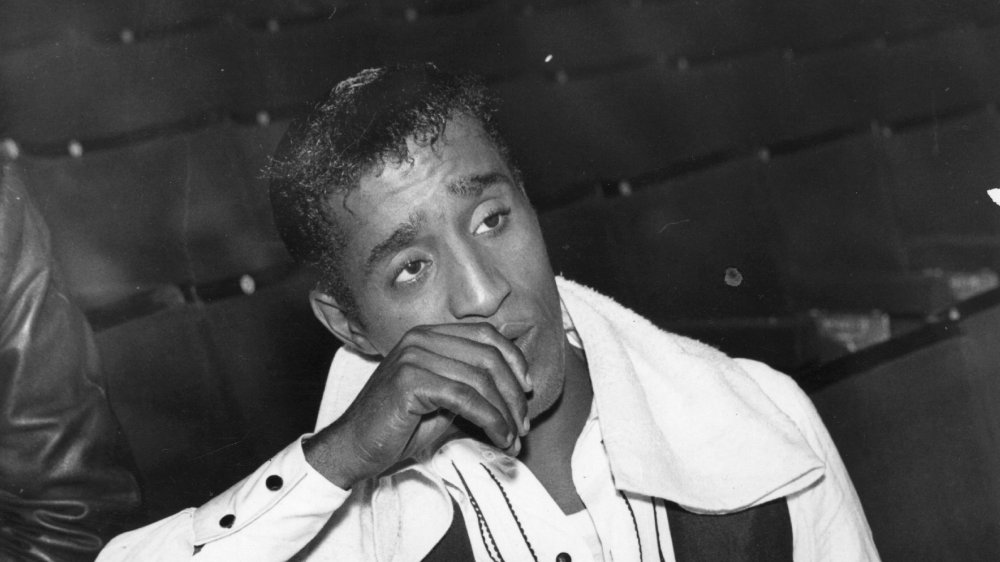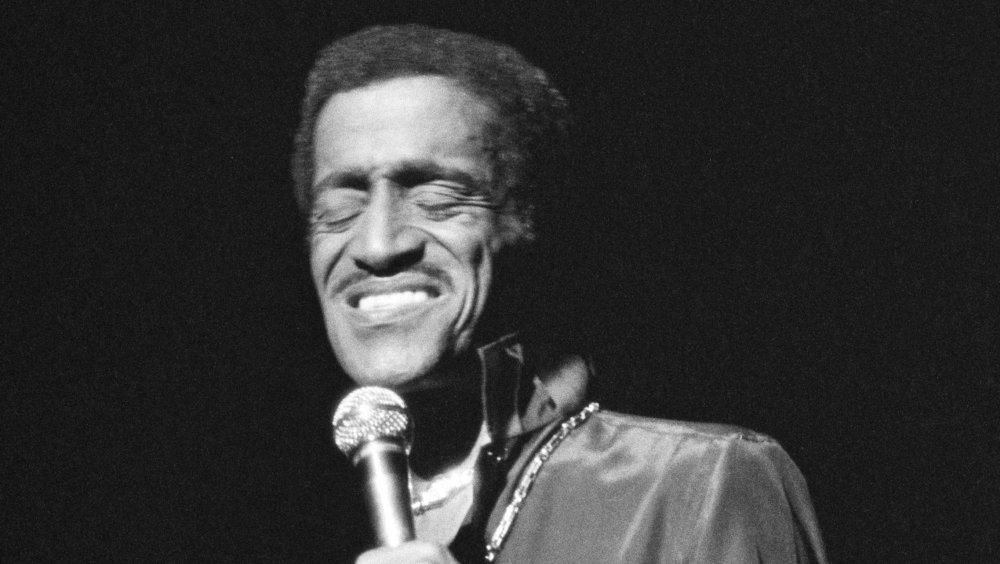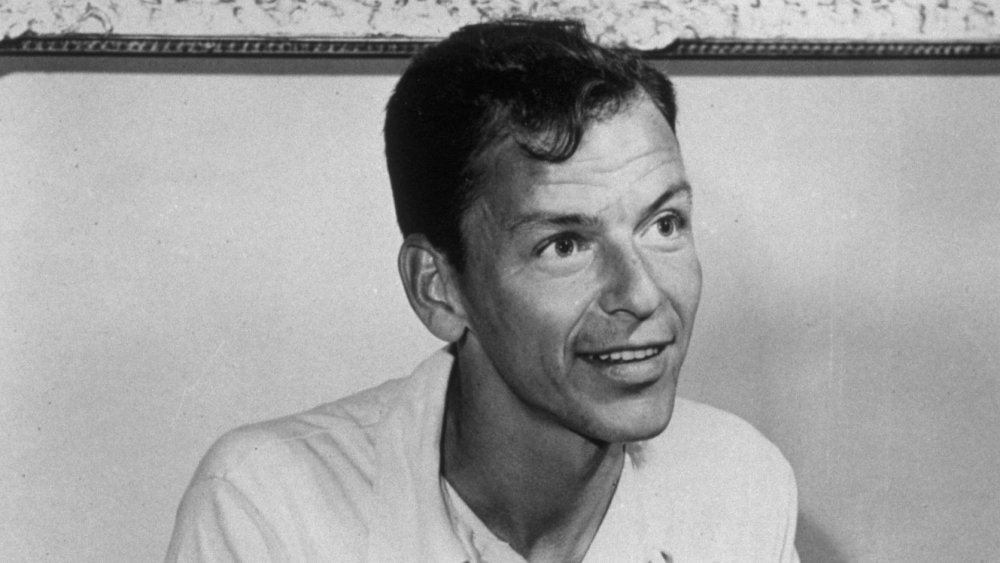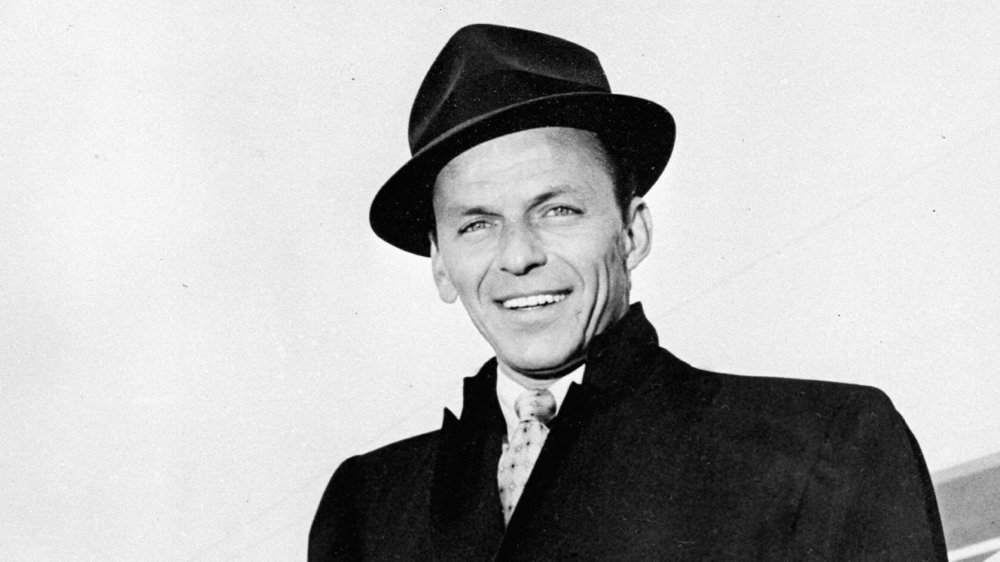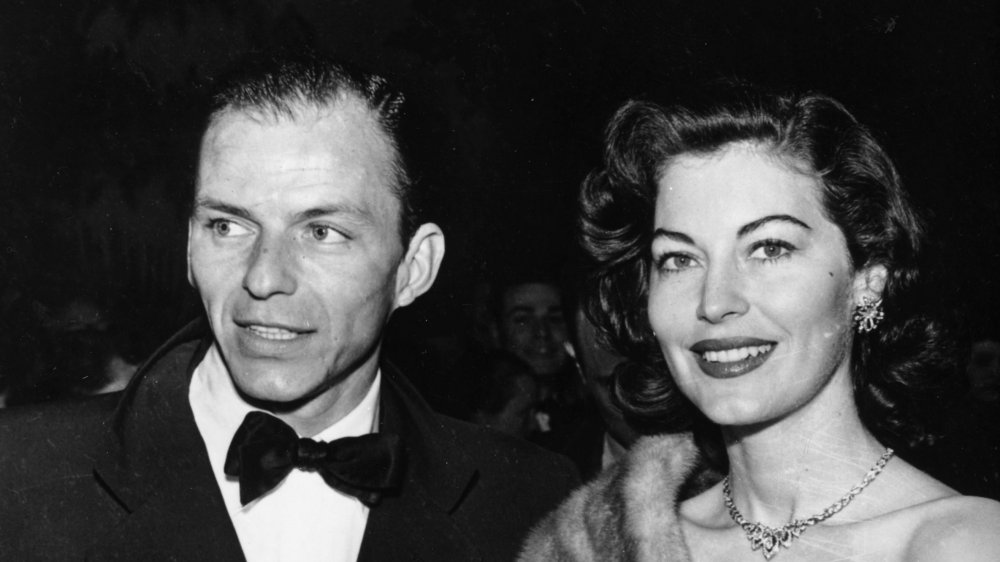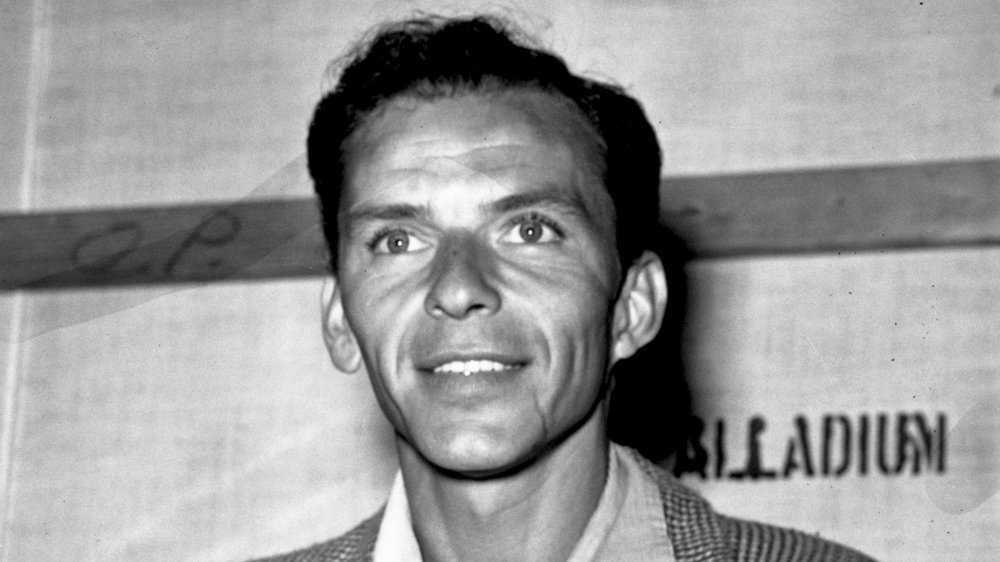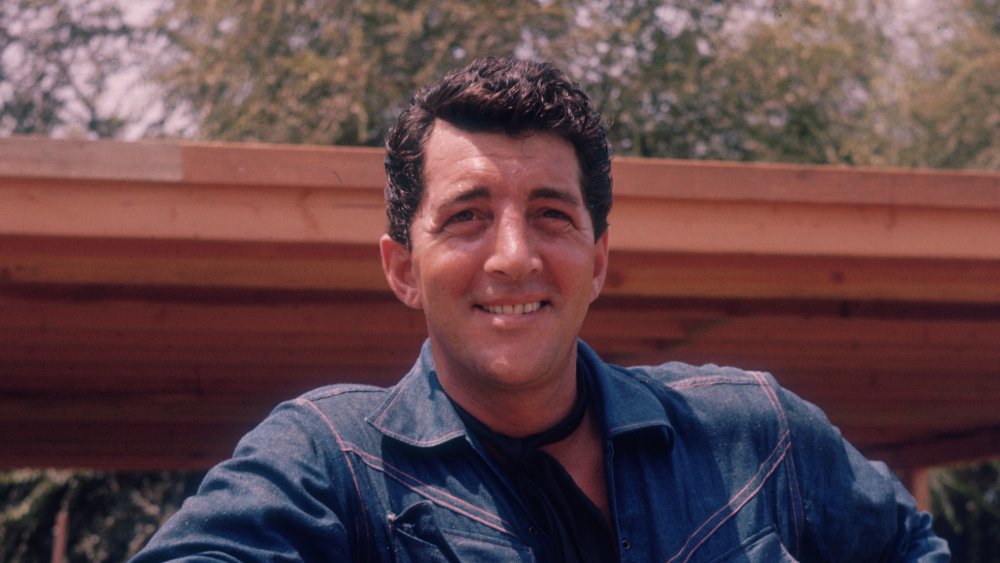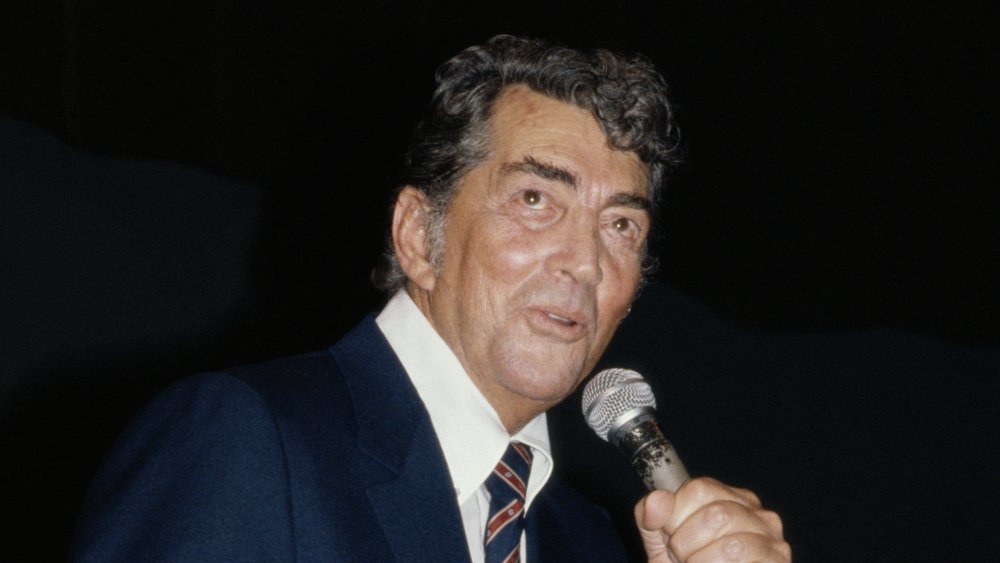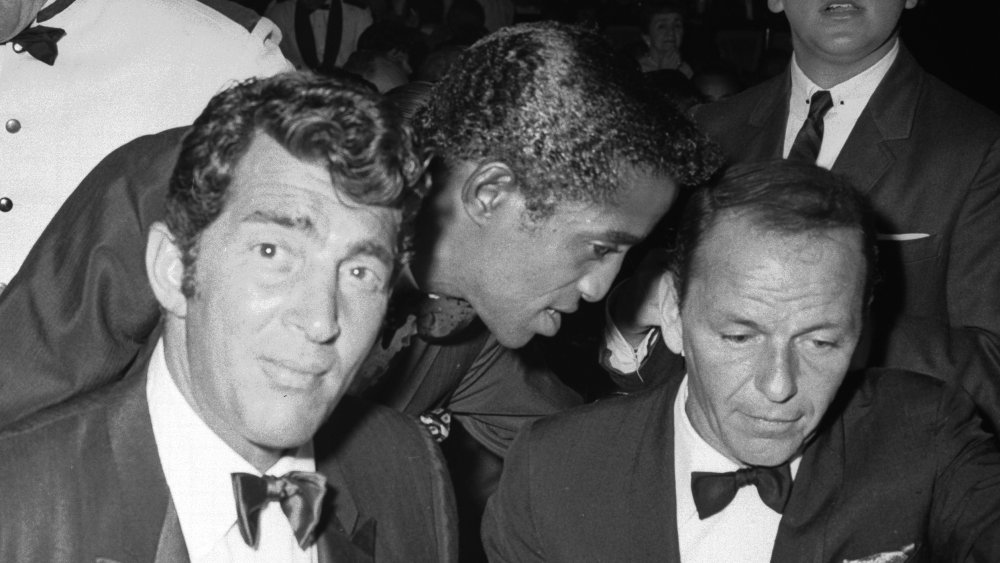The Tragic History Of The Rat Pack
The Rat Pack is the epitome of Mad Men-style old-school cool. As Colin Bertram of Biography tells us, the legendary group of entertainers were originally acquaintances who used to hang around at Humphrey Bogart and Lauren Bacall's home in Los Angeles. Before their most famous line-up, they had a Who's Who list of satellite members that included David Niven, Spencer Tracy, and Robert Mitchum. They were by no means a "men only" club, either: Early on, legendary ladies such as Ava Gardner, Judy Garland, Elizabeth Taylor and Audrey Hepburn counted themselves in the group's ranks. In fact, the Rat Pack didn't even really want to be one. They actually liked to be called "The Summit" or "The Clan."
Still, regardless of their full list of members or original naming aspirations, history has come to know the group as the Rat Pack, and Frank Sinatra, Sammy Davis Jr., Dean Martin, Peter Lawford, and Joey Bishop are considered its core members. As effortlessly awesome as the group appeared to be, there was actually a lot of turmoil and sadness behind the scenes. Today, we'll take a look at the tragic history of the Rat Pack.
Peter Lawford's right hand
If you're hard-pressed to name an iconic Peter Lawford movie, you probably won't be alone. Though his IMDb page shows that his acting career was lengthy and impressive, his entry on the Hollywood Walk of Fame website tells us that Lawford also had a couple of other things playing in his favor. The British-American actor happened to be the brother-in-law of a guy called John F. Kennedy, and in his later years he reaped fame simply from his "off-screen activities as a celebrity."
All of that might seem like Lawford led an absolutely charmed life, but in reality, he suffered from a nasty, debilitating injury to his right hand. The details on how he received it vary. The Walk of Fame page says the hand sustained permanent nerve damage when he fell through a glass door at the age of 14, while the book Peter Lawford Story by Patricia Lawford Stewart and Ted Schwartz tells us that Lawford's hand started to atrophy, and the doctors' treatment where his fingers were forcefully opened left the appendage comparatively normal-looking, but lacking in strength. Regardless, the ensuing injury left his hand with enough damage that he was declared unfit to serve in World War II, and he had to learn to hide it.
Sammy Davis Jr. dealt with a lot of racism
If the Rat Pack were giving out prizes for most tenacious entertainer, Sammy Davis Jr. would have been head and shoulders above the competition. As Carmel Dagan of Variety writes, the sole African-American member of the squad faced racism throughout his career, yet managed to shrug off humiliation after humiliation and build a long, enviable career as an entertainer. He wasn't even safe from racism with his fellow Rat Pack members: The group's shows in Las Vegas often involved racially-themed "comedy," and he was the punchline.
Some people accused Davis of being an "Uncle Tom" (an African-American man that was perceived as being servile to white people), while others saw him as a trailblazer who helped tear down racial barriers. As for the man himself ... well, let's just say that he donated quite a lot of money to the civil rights movement over the years.
Sammy Davis Jr.'s marriage troubles
Sammy Davis Jr. may have been a star, but the era's racists (of whom there were many) made it sure that his skin tone often defined what he could and couldn't do in the eyes of the general public. Carmel Dagan of Variety reports that this was especially evident when Davis married the Swedish actress May Britt in 1960. This was a time when interracial marriages were not only ultra rare — they were outright illegal in no less than 31 states. Davis' daughter has even claimed that John F. Kennedy himself reacted to the situation by stopping Davis from performing at his inauguration.
As Lynn Yager's Vogue article on Britt tells us, the marriage was not without implications for either celebrity. Davis was harassed by Neo-Nazis and racists. The era's segregation practices meant that the couple ran into situations where they couldn't share a hotel room, or even drink from the same fountain. Oh, and Britt's own studio, 20th Century Fox, dropped her as soon as they got married.
Sammy Davis Jr. loses his eye
As Bob Cannon of Entertainment Weekly tells us, November 19, 1954 seemed like just another day in the life of Sammy Davis Jr. doing the exact kind of cool stuff you'd imagine Sammy Davis Jr. doing. He was working on a cool movie soundtrack and driving his cool Cadillac down Route 66, the coolest of all roads. Unfortunately, a decidedly uncool and downright terrifying event interrupted his day, when an elderly lady backed out of her driveway and directly into his path. Unable to avoid the crash, the 28-year-old Davis was sent face first into the steering wheel.
According to the entertainer's daughter Tracy Davis' book, Sammy Davis Jr.: A Personal History with My Father (via ABC News), the impact fractured several bones in his face. The damage to his left eye was even worse, and the now-useless organ was left "dangling from his eye socket." Davis had no option but to get a prosthetic eye and to learn to maneuver on the stage all over again. The incident sent him on a path of much "soul-searching," and affected his eventual choice to convert to Judaism.
Sammy Davis Jr. and the mob
Sammy Davis Jr. had to endure much racial abuse over the years, but as Joy Lanzerdorfer of Smithsonian Magazine tells us, Hollywood was quite fond of him ... until 1957, when he started dating Kim Novak, a major movie star and a white woman. The pair realized that their secret relationship could kill their careers, and kept things on the down low. Still, it didn't sit well with the head of Novak's studio. Unfortunately for Davis, Columbia Pictures' Harry Cohn had ties to the Mafia, and ordered a hit on the entertainer. Reportedly, gangster Mickey Cohen delivered a threat to maim and kill Davis to the singer's horrified father. The only way out: Davis would have to marry a black woman and forget all about Novak.
Davis tried to fight back by contacting his own mob connection, Sam Giancana. However, Giancana's reach couldn't protect Davis in Hollywood, and in the end, the singer ended up giving in to the threats. In early 1958, Davis married singer Loray White in a doomed marriage that wouldn't last until the end of the year. According to a friend, the entertainer was so utterly devastated on his wedding day that he got drunk, attempted to strangle his new wife, and later tried to bring a gun to his own head.
If you or anyone you know is having suicidal thoughts, please call the National Suicide Prevention Lifeline at 1-800-273-TALK (8255).
Frank Sinatra and draft-dodging
Frank Sinatra was the Captain America of the Rat Pack's Avengers, as well as the guy people tend to mean when they talk about how men were cooler and more stylish back in the day. As an entertainer, Ol' Blue Eyes may have radiated effortless class, but his image was tarnished by one thing that followed him throughout much of his life. According to Erin Blakemore of History, Sinatra was thought to have dodged the draft for World War II, which drew much ire and hurt his early career.
As the story went, Sinatra had paid a hefty $40,000 for a doctor to decide he was unfit for service. However, this appears to have been untrue, seeing as even the FBI looked into the allegations and ultimately decided that Sinatra's dismissal had perfectly legitimate reasons behind it — namely, psychological issues and a punctured eardrum. Yet, the rumors persisted. According to NPR, Sinatra's reputation as a draft-dodger made him "one of the most despised men in America" at one point, after Pearl Harbor in particular. Military folks also felt that the young singer was doing his level best to hound their women while they were fighting the enemy abroad. According to Sinatra biographer James Kaplan, of course, they were sort of right about that one.
Sinatra and the Feds
Frank Sinatra had tons of admirers and followers over his career, but there was one persistent group of fans he probably could have done without. As Erin Blakemore of History tells us, we're talking about none other than the Federal Bureau of Investigation.
The FBI kept a file on Ol' Blue Eyes for over 40 years, and compiled thousands of pages on his life, contacts, and (alleged) shenanigans. They became interested in him due to the rumors of his draft-dodging, and after they decided that these were unfounded, they started looking into Sinatra's social circle. The singer's list of acquaintances included several notable mobsters, including big shot Chicago gangster Sam Giancana, the Giacalones from Detroit, and Angelo Bruno of Philadelphia. Sinatra was never prosecuted for these connections, though at one point he grew quite concerned about the mounting rumors of his association with organized crime folks. In 1950, he even approached the FBI and offered to become an informant, in a possible bid to get in their good graces. The Feds declined. After all, they were also looking into him because of his other suspicious activities, such as supposed Communist sympathies and ... his open support of the anti-racist movement? Truly, it was a different time.
Still, the FBI was also known to assist Sinatra on occasion. The most high-profile one of these was in 1963, when the Bureau caught the three men who had kidnapped the singer's son, Frank Jr.
Frank Sinatra and Ava Gardner
To say Frank Sinatra's relationship with actress Ava Gardner had its ups and downs is an understatement of truly colossal properties. According to People, the pair first met in 1943, started dating in 1949 while Sinatra was still married to his first wife, and got married in 1951. In a Vanity Fair article by Gardner and her biographer, Peter Evans, the Hollywood legend reminisced about the time she first met Sinatra, who she described as a "cocky god" who "reeked of sex." When the two eventually hooked up, they indulged in shenanigans like drunk-driving through a small town with guns blazing, shooting at store windows and streetlights.
Gardner also noted that lots of people, including some of Sinatra's former partners, advised her against marrying him. Yet, she chose otherwise ... and before their perhaps inevitable divorce in 1957, they had an incredibly intense relationship pock-marked with separations, two abortions, numerous infidelities (on both parts) and several suicide attempts (on Sinatra's part). Despite all this, the pair remained friends until 1990, when Gardner died.
If you or anyone you know is having suicidal thoughts, please call the National Suicide Prevention Lifeline at 1-800-273-TALK (8255).
Sinatra's suicide attempts
As easy-going and composed as Frank Sinatra seemed in public, the man had his demons. In an interview with NPR, journalist and Sinatra biographer James Kaplan notes that the singer was rather prone to desperate moves behind closed doors. According to Kaplan, Sinatra made three or four suicide attempts over the years, one of which was severe enough that he could have bled to death. Andrew March of PBS says it was four, and writes that the first one happened during the early 1950s during a career slump Sinatra took pretty hard. The other three happened during his relationship with Ava Gardner.
On one occasion, Gardner reportedly walked in a room where Sinatra was holding a gun to his head. As Gardner tried to wrestle the gun away from the singer, it fired, but the shot luckily missed both superstars. As John Brady's book, Frank & Ava: In Love and War, tells us, Gardner found Sinatra's suicide attempts incredibly difficult, especially since he appeared to think that no one would care if he'd end his life. "I care," Gardner said. "He knows that it would blow me apart and that I will always protect him."
If you or anyone you know is having suicidal thoughts, please call the National Suicide Prevention Lifeline at 1-800-273-TALK (8255).
The death of Dino Jr.
Dean Martin's oldest child, Dean Paul, was arguably at least as talented as his father. As Barbara Metzler of Associated Press writes, he had chops as a television performer, and as a musician he'd already had a hit with his band, Dino, Desi, and Billy, which also featured the son of Lucille Ball and Desi Arnaz. Apart from his entertainment career, he was also a talented athlete and a pilot. Unfortunately, that last talent was the one that cost him his life.
On March 1987, Dean Paul Martin and another crewman were flying a fighter jet out of March Air Force Base, California, when a combination of heavy clouds, a 400 mph speed and a presumably unexpected mountainside caused them to crash and instantly perish. As People tells us, Martin initially held out hope that his son might have survived the crash, but when the body was eventually found, the loss weighed heavily on him. According to Martin's friend, Jerry Vale: "He couldn't handle it. After [Dino's death] it seemed he was just walking through life."
Dean Martin's long slide to reclusiveness
Dean Martin's public image may have been that of an easy-going guy who liked a drink and a good time and cared for little else, but as J. D. Reed of People tells us, this wasn't strictly true. Just like the Los Angeles Times notes that the whiskey "Dino" kept sipping during his performances was generally just orange juice, his nonchalant, debonair image was just that — an image.
Martin was actually a shy and somewhat gruff man of few words, and little taste for small talk. By the time his third marriage ended in 1976, he apparently started embracing this side of his personality, to a point that he nearly stopped performing and settled to a semi-hermit state that involved a daily routine of a round of golf, a dinner at his regular club, some drinks, and a Western movie. His seclusion took a turn for the worse in the late 1980s, when a series of people who were important to him — including his eldest son — died over a relatively short period of time. These losses were apparently more than he could take, and he slid further into autopilot. In his last years, though, he did manage to be a bit more social, at least when it came to his family.
The failed reunion tour
As John M. Leighty of UPI writes, the Rat Pack — well, at least Frank Sinatra, Dean Martin, and Sammy Davis Jr. — reunited in 1988 for a tour that was supposed to span 29 cities. As the word "supposed" might tell you, this didn't go quite as smoothly as planned.
According to J. D. Reed of People, the brunt of the blame lies on Martin, who acted incredibly disinterested about the whole thing. He kept slurring through his lines, forgetting lyrics, and acting so hostile that he actually "flicked a live cigarette" into the audience during their show in Oakland. Afterwards, an angry Sinatra redecorated his friend's head with a plate of spaghetti. In the end, the tour fell apart after just six or so nights, as Martin headed straight to Los Angeles, citing kidney problems ... yet appearing in Las Vegas only days later, joking, "Frank sent me a kidney, but I don't know whose it was."
The incident effectively destroyed the decades-long friendship between Sinatra and Martin. The pair only reconciled mere weeks before Martin's death.
